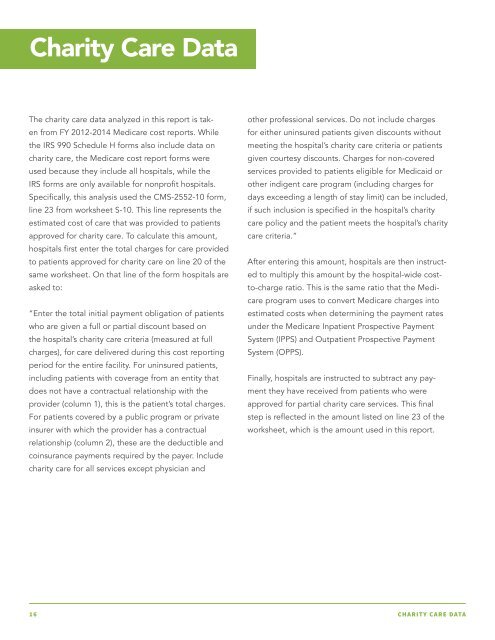BENEFITING HOSPITALS NOT PATIENTS
1rI7CJA
1rI7CJA
Create successful ePaper yourself
Turn your PDF publications into a flip-book with our unique Google optimized e-Paper software.
Charity Care Data<br />
The charity care data analyzed in this report is taken<br />
from FY 2012-2014 Medicare cost reports. While<br />
the IRS 990 Schedule H forms also include data on<br />
charity care, the Medicare cost report forms were<br />
used because they include all hospitals, while the<br />
IRS forms are only available for nonprofit hospitals.<br />
Specifically, this analysis used the CMS-2552-10 form,<br />
line 23 from worksheet S-10. This line represents the<br />
estimated cost of care that was provided to patients<br />
approved for charity care. To calculate this amount,<br />
hospitals first enter the total charges for care provided<br />
to patients approved for charity care on line 20 of the<br />
same worksheet. On that line of the form hospitals are<br />
asked to:<br />
“Enter the total initial payment obligation of patients<br />
who are given a full or partial discount based on<br />
the hospital’s charity care criteria (measured at full<br />
charges), for care delivered during this cost reporting<br />
period for the entire facility. For uninsured patients,<br />
including patients with coverage from an entity that<br />
does not have a contractual relationship with the<br />
provider (column 1), this is the patient’s total charges.<br />
For patients covered by a public program or private<br />
insurer with which the provider has a contractual<br />
relationship (column 2), these are the deductible and<br />
coinsurance payments required by the payer. Include<br />
charity care for all services except physician and<br />
other professional services. Do not include charges<br />
for either uninsured patients given discounts without<br />
meeting the hospital’s charity care criteria or patients<br />
given courtesy discounts. Charges for non-covered<br />
services provided to patients eligible for Medicaid or<br />
other indigent care program (including charges for<br />
days exceeding a length of stay limit) can be included,<br />
if such inclusion is specified in the hospital’s charity<br />
care policy and the patient meets the hospital’s charity<br />
care criteria.”<br />
After entering this amount, hospitals are then instructed<br />
to multiply this amount by the hospital-wide costto-charge<br />
ratio. This is the same ratio that the Medicare<br />
program uses to convert Medicare charges into<br />
estimated costs when determining the payment rates<br />
under the Medicare Inpatient Prospective Payment<br />
System (IPPS) and Outpatient Prospective Payment<br />
System (OPPS).<br />
Finally, hospitals are instructed to subtract any payment<br />
they have received from patients who were<br />
approved for partial charity care services. This final<br />
step is reflected in the amount listed on line 23 of the<br />
worksheet, which is the amount used in this report.<br />
16 CHARITY CARE DATA


